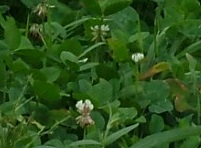Alice white clover (Trifolium repens) is a perennial legume which spreads through the sward with branching stolons. As with other legumes, such as alfalfa and red clover, white clover has the ability to produce its own nitrogen through a symbiotic process with Rhizobium bacteria in the root nodules. White clover is mainly used in grazing pastures for its high nutritive value (both protein and minerals). Traditionally, there are two types of white clover: the small leafed and highly persistent varieties and the large leafed and less persistent varieties. Alice white clover is the first variety that successfully combines production (large leaves) and persistence.
Site Selection and Planting
White clover does well on most soil types, however, the pH of the soil is rather important. The pH should be at least 6.0, and the optimum is 7.0. If the pH is too low, high-calcium lime should be applied. Adequate levels of calcium, phosphorus and potash are very important. Alice white clover is a perfect companion with most cool season perennials like perennial ryegrass, orchardgrass and tall fescue. For combinations with Italian and annual ryegrass, red clover is a better choice.
Alice white clover can be planted in the fall, at least 8 weeks before killing frosts. A better way of planting in the Northern regions is frost-seeding in the early spring. When planted with grass, 2 to 3 pounds per acre is sufficient. For frost-seeding, 4 pounds per acre is recommended.
Seed Inoculation
White clover can only fix nitrogen when the proper Rhizobium bacteria are present in the soil. To ensure nitrogen fixation, white clover seed should be inoculated with the right strain of Rhizobia prior to planting. Barenbrug offers pre-inoculated and coated Alice white clover seed that is ready to plant.

